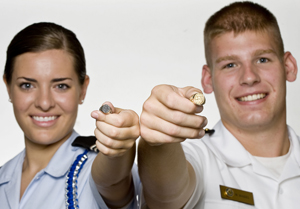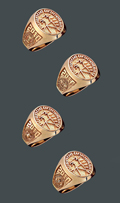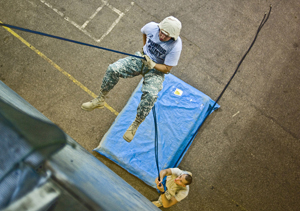Writer: Jeanne Norberg, 765-494-2084; jnorberg@purdue.edu
Source: J. Dion Bates, 765-494-2099, jdbates@purdue.edu
Source: Michael Massel, 317-979-7726, mmassel@purdue.edu
Note to Journalists: Journalists are welcome to cover the event. The Commissioning Ring Ceremony will begin after the dinner, which begins at 6:30 p.m.
WEST LAFAYETTE, Ind. - Purdue University will join a handful of other campuses with a new tradition honoring its ROTC seniors.
For the first time, the university has authorized the creation of a class ring custom designed for a specific group. The first rings will be awarded at an event beginning 6:30 p.m. Oct. 8 in the Purdue Memorial Union North Ballroom. The guest speaker, Maj. Gen. Erika Steuterman, is a member of the Purdue ROTC Hall of Fame who designs overall strategic plans and programs for the Air Force.
“This is an amazing group of students who have a college experience much unlike any others”,” said Lt. Col. Dion Bates, department head for Purdue Army ROTC. “They are up before sunrise for physical training at least several days a week, take extra classes and drill weekly, and some elect to take flight training. Two weekends a year, Army ROTC takes part in field training exercises at Camp Atterbury, where they get hands-on experience with everything from rappelling to tactical patrolling to weapons firing.”
“Service before self” is their true north, said Commander Timothy Downing, Purdue Navy ROTC.
“They spend hours at community service ranging from visiting the residents of the Veteran’s Home to serving as a big brother or sister at Klondike Elementary School,” Downing said. “They build with Habitat for Humanity, usher at Elliott Hall of Music and Ross-Ade Stadium, and even clean the stands after every home football game.”
And their summers are not their own. As upperclassmen, they have special obligations that might find them onboard destroyers in the Mediterranean, below the waves in a submarine, learning survival skills in the Sierra Nevada Mountains, or leading maneuvers at Fort Lewis near Tacoma, Wash. All that, and their GPA is above the campus average, even though 80 percent are enrolled in technical majors.”
The ring features the crest of each student’s branch of service on one side while the other side features the Purdue Memorial Union, built after World War I to honor all who lost their lives while serving in uniform. A griffin, the university’s symbol that represents strength, is engraved on the top.
“Because of the physical nature of military life, our committee asked Balfour to design not only gold rings but also a line made of stainless steel that will hold up while deployed,” Massel said. “It’s different than the standard class ring, which usually has a colored stone on top. Ours is distinctive.”
ROTC at Purdue dates back to 1888, and until 1964 male students were required to either join ROTC or band. ROTC enrollment at Purdue has ranged from 850 to 3,275 during World War II. Today, about 480 students are enrolled in all three ROTC branches.
Other institutions with an ROTC class ring, besides the military academies, include Texas A&M, Virginia Military Institute, Virginia Tech and North Carolina State universities.
Purdue ROTC living alumni number more than 12,000 and include:
- Eight astronauts, including Neil Armstrong and Eugene Cernan, the first and most recent men on the moon.
- Frederick C. Branch, the first African-American commissioned an officer in the Marine Corps. Earlier denied access to Officer Training School, he received his officer’s training in the Navy V-12 program at Purdue and was commissioned as second lieutenant on Nov. 10, 1945.
- Vice Admiral Carol Pottenger, one of the first women selected for sea duty, she also was the first female admiral to be commander of a strike group (Amphibious Force 7th Fleet/ESG 7 at White Beach, Okinawa).
- Retired Maj. Gen. Craig Whelden, deputy commander of the Pacific Army.
- Harry J. Michael, 2nd Lt. U.S. Army, who received the Medal of Honor for his actions in Germany during World War II.
After graduation, those who received ROTC’s scholarships or enrolled in the ROTC Advance Course after their sophomore year are obligated to serve in either active or reserve duty or with a national guard unit for three to four years. Scholarships cover full tuition and provide a book allowance and a monthly stipend.



